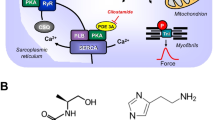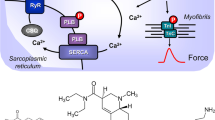Abstract
We determined the affinity and/or potency of the novel H3 receptor antagonist iodoproxyfan atα 2 and 5-HT3 receptors. Iodoproxyfan and rauwolscine (a referenceα 2 ligand) (i) monophasically displaced3H-rauwolscine binding to rat brain cortex membranes (pKi 6.79 and 8.59); (ii) facilitated the electrically evoked tritium overflow from superfused mouse brain cortex slices preincubated with3H-noradrenaline (pEC50 6.46 and 7.91) and (iii) produced rightward shifts of the concentration-response curve (CRC) of (unlabelled) noradrenaline for its inhibitory effect on the evoked overflow (pA2 6.65 and 7.88). In the guinea-pig ileum, iodoproxyfan 6.3µmol/l failed to evoke a contraction by itself but depressed the maximum of the CRC of 5-hydroxytryptamine (pD′2 5.24). Tropisetron (a reference 5-HT3 antagonist) produced rightward shifts of the CRC of 5-hydroxytryptamine (pA2 7.84). In conclusion, the affinity/potency of iodoproxyfan at H3 receptors (range 8.3-9.7 [1]) exceeds that atα 2 receptors by at least 1.5 log units and that at 5-HT3 receptors by at least 3 log units.
Similar content being viewed by others
References
Ligneau X, Garbarg M, Vizuete ML, Diaz J, Purand K, Stark H, et al. [125I]Iodoproxyfan, a new antagonist to label and visualize histamine H3 receptors. J Pharmacol Exp Ther 1994;271:452–9.
Arrang JM, Garbarg M, Lancelot JC, Lecomte JM, Pollard H, Robba M, et al. Highly potent and selective ligands for histamine H3-receptors. Nature 1987;327:117–23.
Jansen FP, Rademaker B, Bast A, Timmerman H. The first radiolabeled histamine H3 receptor antagonist, [125I]-iodophenpropit: saturable and reversible binding to rat cortex membranes. Eur J Pharmacol 1992;217:203–5.
van der Goot H, Schepers MJP, Sterk GJ, Timmerman H. Isothiourea analogues of histamine as potent agonists or antagonists of the histamine H3-receptor. Eur J Med Chem 1992;27:511–8.
Yanai K, Ryu JH, Sakai N, Takahashi T, Iwata R, Ido T, et al. Binding characteristics of a histamine H3-receptor antagonist, [3H]S-methylthioperamide: comparison with [3H](R)α-methylhistamine binding to rat tissues. Jpn J Pharmacol 1994;65:107–12.
Leurs R, Tulp MTM, Menge WMBP, Zuiderveld OP, Adolfs MJP, Timmerman H. Pharmacology of the histamine H3 receptor antagonists iodophenpropit and thioperamide. Histamine Neuroscience Research Group, Satellite Symposium of the Neuroscience Meeting, November 13, 1994, Miami, FL Abstract 7, 1994.
Butler A, Burridge J, Kilpatrick GJ. The receptor selectivity of the H3 receptor antagonist thioperamide. New Perspectives in Histamine Research, Satellite Symposium of the XIth International Congress of Pharmacology of IUPHAR, July 6–8, Noordwijkerhout, The Netherlands, Abstract P02 (1990).
Schlicker E, Fink K, Hinterthaner M, Göthert M. Inhibition of noradrenaline release in the rat brain cortex via presynaptic H3 receptors. Naunyn-Schmiedeberg's Arch Pharmacol 1989;340:633–8.
Timmerman H, Vollinga RC, Jansen FP, Bertaccini G, Leurs R. In vitro and in vivo activities of immepip (VUF 4708), a new potent histamine H3 receptor agonist. Naunyn-Schmiedeberg's Arch Pharmacol 1995;351:R57.
Weitzell R, Tanaka T, Starke K. Pre- and postsynaptic effects of yohimbine stereoisomers on noradrenergic transmission in the pulmonary artery of the rabbit. Naunyn-Schmiedeberg's Arch Pharmacol 1979;308:127–36.
Richardson BP, Engel G, Donatsch P, Stadler PA. Identification of serotonin M-receptor subtypes and their specific blockade by a new class of drugs. Nature 1985;316:126–31.
Bradford MM. A rapid and sensitive method for the quantitation of microgram quantities of protein utilizing the principle of protein-dye binding. Anal Biochem 1976;72:248–54.
Schlicker E, Kathmann M, Exner HJ, Detzner M, Göthert M. The 5-HT3 receptor agonist 1-(m-chlorophenyl)-biguanide facilitates noradrenaline release by blockade ofα 2-adrenoceptors in the mouse brain cortex. Naunyn-Schmiedeberg's Arch Pharmacol 1994;349:20–4.
Hedler L, Stamm G, Weitzell R, Starke K. Functional characterization of centralα-adrenoceptors by yohimbine diastereomers. Eur J Pharmacol 1981;70:43–52.
Furchgott RF. The classification of adrenoceptors (adrenergic receptors). An evaluation from the standpoint of receptor theory. In: Handbook of experimental pharmacology, vol. XXXIII. Blaschko H, Muscholl E, editors. Berlin: Springer, 1972:283–335.
Buchheit KH, Engel G, Mutschler E, Richardson B. Study of the contractile effect of 5-hydroxytryptamine (5-HT) in the isolated longitudinal muscle strip from guinea-pig ileum. Evidence for two distinct release mechanisms. Naunyn-Schmiedeberg's Arch Pharmacol 1985;329:36–41.
Pertz H, Elz S. In-vitro pharmacology of sarpogrelate and the enantiomers of its major metabolite: 5-HT2A receptor specificity, stereoselectivity and modulation of ritanserin-induced depression of 5-HT contractions in rat tail artery. J Pharm Pharmacol 1995;47:310–6.
Arunlakshana O, Schild HO. Some quantitative uses of drug antagonists. Brit J Pharmacol 1959;14:48–58.
van Rossum JM. Cumulative dose-response curves. II. Technique for the making of dose-response curves in isolated organs and the evaluation of drug parameters. Arch Int Pharmacodyn 1963;143:299–330.
Schlicker E, Behling A, Lümmen G, Malinowska B, Göthert M. Mutual interaction of histamine H3-receptors andα 2-adrenoceptors on noradrenergic terminals in mouse and rat brain cortex. Naunyn-Schmiedeberg's Arch Pharmacol 1992;345:639–46.
Limberger N, Trendelenburg AU, Starke K. Subclassification of presynapticα 2-adrenoceptors:α 2D-autoreceptors in mouse brain. Naunyn-Schmiedeberg's Arch Pharmacol. In press.
Bylund DB, Eikenberg DC, Hieble JP, Langer SZ, Lefkowitz RJ, Minneman KP, et al. IV. International Union of Pharmacology. Nomenclature of adrenoceptors. Pharmacol Rev 1994;46:121–36.
Craig DA, Eglen RM, Walsh LKM, Perkins LA, Whiting RL, Clarke DE. 5-Methoxytryptamine and 2-methyl-5-hydroxy-tryptamine-induced desensitization as a discriminative tool for the 5-HT3 and putative 5-HT4 receptors in guinea pig ileum. Naunyn-Schmiedeberg's Arch Pharmacol 1990;342:9–16.
Author information
Authors and Affiliations
Rights and permissions
About this article
Cite this article
Schlicker, E., Pertz, H., Bitschnau, H. et al. Effects of iodoproxyfan, a potent and selective histamine H3 receptor antagonist, onα 2 and 5-HT3 receptors. Inflamm Res 44, 296–300 (1995). https://doi.org/10.1007/BF02032572
Received:
Revised:
Accepted:
Issue Date:
DOI: https://doi.org/10.1007/BF02032572




